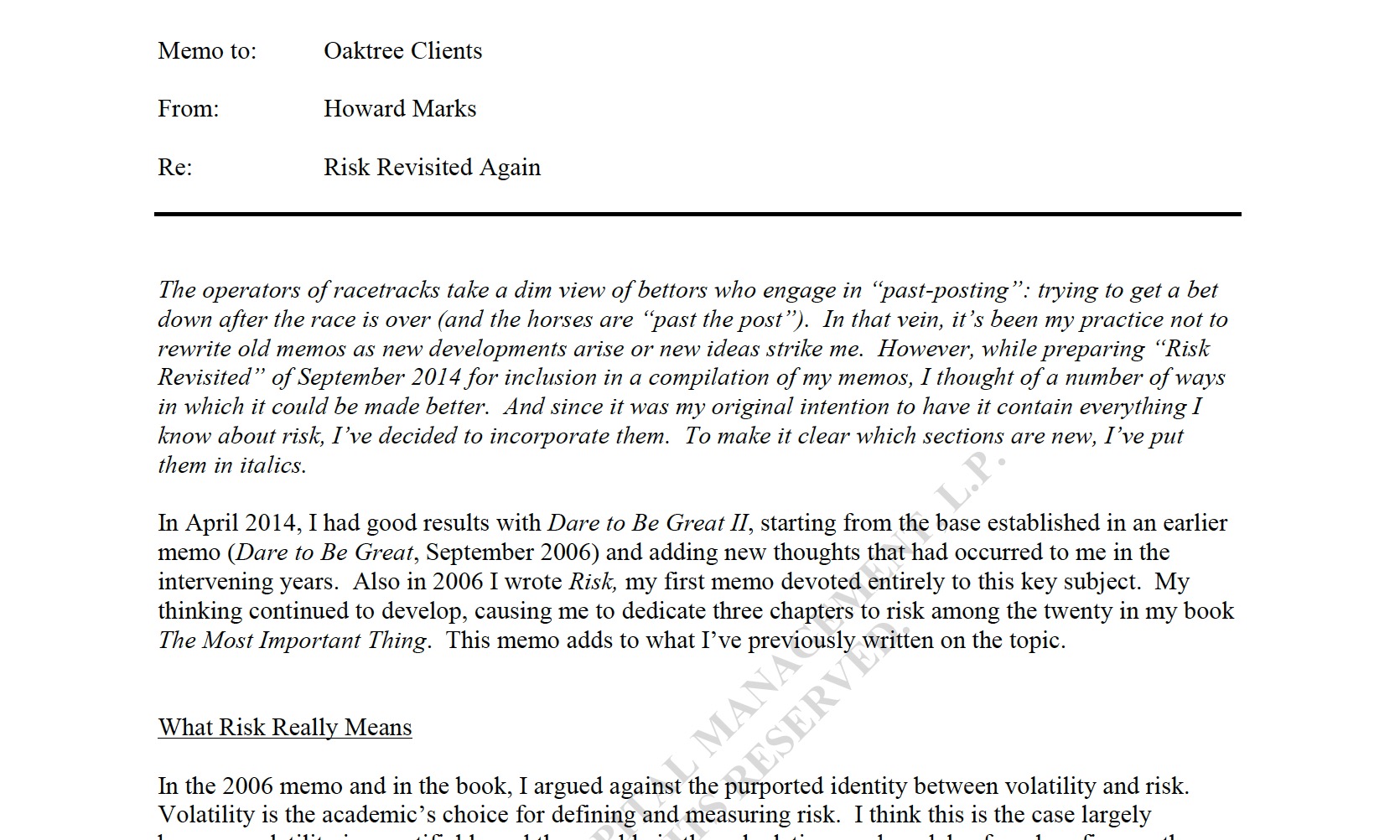by Howard Marks, Oaktree Capital
In April 2014, I had good results with Dare to Be Great II, starting from the base established in an earlier memo (Dare to Be Great, September 2006) and adding new thoughts that had occurred to me in the intervening years. Also in 2006 I wrote Risk, my first memo devoted entirely to this key subject. My thinking continued to develop, causing me to dedicate three chapters to risk among the twenty in my book The Most Important Thing. This memo adds to what I’ve previously written on the topic.
What Risk Really Means
In the 2006 memo and in the book, I argued against the purported identity between volatility and risk. Volatility is the academic’s choice for defining and measuring risk. I think this is the case largely because volatility is quantifiable and thus usable in the calculations and models of modern finance theory. In the book I called it “machinable,” and there is no substitute for the purposes of the calculations.
Permanent loss is very different from volatility or fluctuation. A downward fluctuation – which by definition is temporary – doesn’t present a big problem if the investor is able to hold on and come out the other side. A permanent loss – from which there won’t be a rebound – can occur for either of two reasons: (a) an otherwise-temporary dip is locked in when the investor sells during a downswing – whether because of a loss of conviction; requirements stemming from his timeframe; financial exigency; or emotional pressures, or (b) the investment itself is unable to recover for fundamental reasons. We can ride out volatility, but we never get a chance to undo a permanent loss.
In Dare to Be Great II, I described the time I spent advising a sovereign wealth fund about how to organize for the next thirty years. My presentation was built significantly around my conviction that risk can’t be quantified a priori. Another of their advisors, a professor from a business school north of New York, insisted it can. This is something I prefer not to debate, especially with people who’re sure they have the answer but haven’t bet much money on it.
One of the things the professor was sure could be quantified was the maximum a portfolio could fall under adverse circumstances. But how can this be so if we don’t know how adverse circumstances can be or how they will influence returns? We might say “the market probably won’t fall more than x% as long as things aren’t worse than y and z,” but how can an absolute limit be specified? I wonder if the professor had anticipated that the S&P 500 could fall 57% in the global crisis.
While writing the original memo on risk in 2006, an important thought came to me for the first time. Forget about a priori; if you define risk as anything other than volatility, it can’t be measured even after the fact. If you buy something for $10 and sell it a year later for $20, was it risky or not? The novice would say the profit proves it was safe, while the academic would say it was clearly risky, since the only way to make 100% in a year is by taking a lot of risk. I’d say it might have been a brilliant, safe investment that was sure to double or a risky dart throw that got lucky.
If you make an investment in 2012, you’ll know in 2014 whether you lost money (and how much), but you won’t know whether it was a risky investment – that is, what the probability of loss was at the time you made it. To continue the analogy, it may rain tomorrow, or it may not, but nothing that happens tomorrow will tell you what the probability of rain was as of today. And the risk of rain is a very good analogue (although I’m sure not perfect) for the risk of loss.
People Smarter Than Me
Peter Bernstein, who passed away in 2009, was one of the smartest people I ever met: a real investment sage. He combined a brilliant and learned mind, great common sense, and the ability to express himself with incredible clarity. I found a great deal of inspiration in his newsletter “Economics and Portfolio Strategy,” in his book “Against the Gods: The Remarkable Story of Risk,” and in our correspondence.
One of the newsletter’s best issues, from June 2007, was titled “Can We Measure Risk with a Number?” It provided Peter’s answer to that question, buttressed by the words of a number of great thinkers. It’s so good that I want to share parts here (with all emphasis added but the first). This memo is greatly enhanced by their inclusion:
In life – and in investing – the biggest risks cannot be reduced to a hard number. As Bill Sharpe put it to me recently, “It’s dangerous, at least in general, to think of risk as a number . . . . The problem we face is that there are many scenarios that can unfold in the future. . . .” John Maynard Keynes, [in the 1920s], had this to say: “There is little likelihood of our discovering a method of recognizing particular probabilities, without any assistance whatever from intuition or direct judgment. . . . A proposition is not probable because we think it so.”
Read/Download the complete report below, or here:















